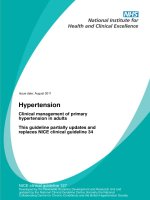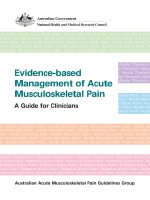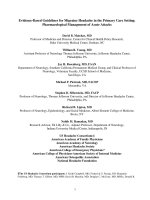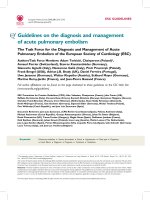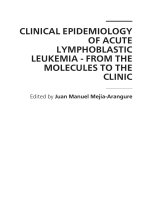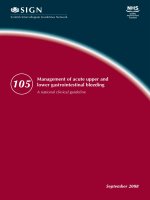WHO/UNICEF JOINT STATEMENT CLINICAL MANAGEMENT OF ACUTE DIARRHOEA pot
Bạn đang xem bản rút gọn của tài liệu. Xem và tải ngay bản đầy đủ của tài liệu tại đây (235.72 KB, 8 trang )
WHO/UNICEF JOINT STATEMENT
CLINICAL MANAGEMENT OF
ACUTE DIARRHOEA
ACUTE DIARRHOEA STILL A
LEADING CAUSE OF CHILD
DEATHS
Though the mortality rate for children under five
suffering from acute diarrhoea has fallen from 4.5
million deaths annually in 1979 to 1.6 million deaths in
2002, acute diarrhoea continues to exact a high toll on
children in developing countries.
Oral rehydration salts (ORS) and oral rehydration
therapy (ORT), adopted by UNICEF and WHO in the
late 1970s, have been successful in helping manage
diarrhoea among children. It is estimated that in the
1990s, more than 1 million deaths related to diarrhoea
may have been prevented each year, largely
attributable to the promotion and use of these
therapies. Today, however, there are indications that
in some countries knowledge and use of appropriate
home therapies to successfully manage diarrhoea,
including ORT, may be declining.
THE GOALS
The revised recommendations will help reduce mortality
from diarrhoea, in line with global goals that aim to:
• Reduce by one half deaths due to diarrhoea among
children under five by 2010 compared to 2000
(‘A World Fit for Children’, outcome document
of the UN Special Session on Children)
• Reduce by two thirds the mortality rate among
children under five by 2015 compared to 1990
(United Nations Millennium Development Goals)
2
Two recent advances in managing diarrhoeal disease – newly formulated oral rehydration
salts (ORS) containing lower concentrations of glucose and salt, and success in using zinc
supplementation – can drastically reduce the number of child deaths. The new methods,
used in addition to prevention and treatment of dehydration with appropriate fluids,
breastfeeding, continued feeding and selective use of antibiotics, will reduce the duration
and severity of diarrhoeal episodes and lower their incidence. Families and communities
are key to achieving the goals set for managing the disease by making the new
recommendations routine practice in the home and health facility.
Sources: For cause-specific mortality:
The World Health Report
2003,
WHO, Geneva. For malnutrition: Pelletier, D. L., E. A. Frongillo,
and J. P. Habicht, ‘Epidemiologic evidence for a potentiating effect
of malnutrition on child mortality’,
American Journal of Public
Health,
vol. 83, no. 8, August 1993, pp. 1130-1133.
Note: The figures for proportional mortality related to children
under five are currently under review by UNICEF and WHO.
Major causes of death among children
under five in developing countries, 2002
25%
23%
4%
5%
10%
15%
18%
Acute respiratory infections
Diarrhoea
Malaria
Measles
HIV/AIDS
Perinatal
Other
3
JOINT STATEMENT
More than 1.5 million children under five continue to
die each year as a result of acute diarrhoea. The
number can be dramatically reduced through critical
therapies such as prevention and treatment of
dehydration with ORS and fluids available in the
home, breastfeeding, continued feeding, selective use
of antibiotics and zinc supplementation for 10–14 days.
These new recommendations, formulated by UNICEF
and WHO in collaboration with the United States
Agency for International Development (USAID) and
experts worldwide, take into account new research
findings while building on past recommendations.
Success in reducing death and illness due to
diarrhoea depends on acceptance of the scientific
basis and benefits of these therapies by governments
and the medical community. It also depends on
reinforcing family knowledge of prevention and
treatment of diarrhoea, and providing information and
support to underserved families.
PROGRESS AND CHALLENGES
NEW DEVELOPMENTS
Recent scientific advances have informed these
revised recommendations. They are:
• Development of an improved formula for ORS
solution with reduced levels of glucose and salt,
which shortens the duration of diarrhoea and the
need for unscheduled intravenous fluids
1
• Demonstration that zinc supplements given during
an episode of acute diarrhoea reduce the duration
and severity of the episode
2
, and
• Findings that zinc supplementation given for 10–14
days lowers the incidence of diarrhoea in the
following 2–3 months
3
Many more lives can be saved if these advances are
used in conjunction with effective home treatment
and use of appropriate health services. To be most
effective, these revised recommendations must
become routine practice both in the home and health
facility. (See the Technical Annex on page 6 for
additional details.)
BUILDING ON PAST SUCCESSES
ORS, ORT and other components of clinical
management of diarrhoea have made a significant
contribution to reducing deaths from diarrhoea.
However, if the global goals are to be met, there is still
much to do.
Family knowledge about diarrhoea must be reinforced
in areas such as prevention, nutrition, ORT/ORS use,
zinc supplementation, and when and where to seek
care. Where feasible, families should be encouraged
to have ORS ready-to-mix packages and zinc (syrup or
tablet), readily available for use, as needed.
Breastfeeding should continue simultaneously with
the administration of appropriate fluids or ORS.
RECOMMENDATIONS
The revised recommendations emphasize family and
community understanding of managing diarrhoea.
When they become routine practice, caretakers will
act quickly at the first sign of diarrhoea, rather than
waiting before treating the child. The aim is that the
recommendations become routine practice both in the
home and health-care facility.
MOTHERS AND OTHER CAREGIVERS SHOULD
• Prevent dehydration through the early administration
of increased amounts of appropriate fluids available
in the home, and ORS solution, if on hand
• Continue feeding (or increase breastfeeding) during,
and increase all feeding after the episode
• Recognize the signs of dehydration and take the
child to a health-care provider for ORS or
intravenous electrolyte solution, as well as
familiarize themselves with other symptoms
requiring medical treatment (e.g., bloody diarrhoea)
• Provide children with 20 mg per day of zinc
supplementation for 10–14 days (10 mg per day for
infants under six months old).
HEALTH-CARE WORKERS SHOULD
4
• Counsel mothers to begin administering suitable
available home fluids immediately upon onset of
diarrhoea in a child
• Treat dehydration with ORS solution (or with an
intravenous electrolyte solution in cases of severe
dehydration)
• Emphasize continued feeding or increased breast-
feeding during, and increased feeding after the
diarrhoeal episode
• Use antibiotics only when appropriate, i.e. in the
presence of bloody diarrhoea or shigellosis, and
abstain from administering anti-diarrhoeal drugs
• Provide children with 20 mg per day of zinc
supplementation for 10–14 days (10 mg per day for
infants under six months old)
• Advise mothers of the need to increase fluids and
continue feeding during future episodes.
Health-care workers treating children for diarrhoea are
encouraged to provide caretakers with two 1-litre
packets of the new ORS, for home-use until the
diarrhoea stops. Caretakers should also be provided
with enough zinc supplements to continue home
treatment for 10–14 days. Printed material (including
text and illustrations) with advice on preventing and
treating diarrhoea at home should accompany the
ORS and zinc supplements.
COUNTRIES SHOULD
• Develop a 3–5 year plan to reduce mortality rates
from diarrhoeal diseases
• Assess progress in controlling diarrhoeal diseases by
monitoring usage rates of ORT/ORS, home-based
treatment and zinc supplementation
• Using the media and face-to-face communication,
promote and refine messages on diarrhoea
prevention, home management of diarrhoea and
appropriate care-seeking
• Prioritize improving the availability of the new ORS
solution and zinc supplements through private and
public channels
• Craft suitable strategies to educate health-care
workers at all levels about using the new ORS and
zinc supplements in treating diarrhoea
• Promote the availability of a zinc formulation that is
cost-effective and easily administered to both infants
and children
• Identify obstacles to the use of ORS, zinc
supplements and home-based treatments in
managing acute diarrhoea.
4
5
UNICEF, WHO AND OTHER PARTNERS WILL
SUPPORT THESE ACTIONS BY
• Advocating, facilitating and investing resources to
ensure country adoption and implementation of
these revised recommendations
• Working with governments and the private sector,
including non-governmental organizations and
businesses, to rapidly disseminate these
recommendations
• Supplying new ORS and zinc supplements to
countries that cannot manufacture them to quality
standards
• Helping with communication efforts aimed at
enhancing prevention and management of
diarrhoea, including promoting routine use of new
ORS and zinc supplements.
REFERENCES
1. Department of Child and Adolescent Health and Development, World Health Organization, ‘Reduced osmolarity oral rehydration salts
(ORS) formulation – Report from a meeting of experts jointly organized by UNICEF and WHO’ (WHO/FCH/CAH/01.22), New York, 18 July
2001 < />2. Bahl, R., et al., ‘Effect of zinc supplementation on clinical course of acute diarrhoea‘ – Report of a Meeting, New Delhi, 7-8 May 2001.
Journal of Health, Population and Nutrition,
vol. 19, no. 4, December 2001, pp. 338-346.
3. Bhutta Z.A., Black, R.E., Brown K. H., et al., ‘Prevention of diarrhoea and pneumonia by zinc supplementation in children in developing
countries: Pooled analysis of randomized controlled trials’, Zinc Investigators’ Collaborative Group,
Journal of Paediatrics,
vol. 135, no.
6, December 1999, pp. 689-697.
4. For more details on the management of acute diarrhoea, consult ‘The Treatment of Diarrhoea – A manual for physicians and other senior
health workers’, WHO/CAH/03.7, World Health Organization, Geneva.
PHOTO CREDITS: Cover: A young Bangladeshi mother helps her healthy baby to stand, © UNICEF/HQ93-1880/Shamsuz Zaman;
Page 3: A health-care worker spoon-feeds an ORS solution to a sick infant in the paediatrics ward of Kaduna Hospital, Nigeria,
© UNICEF/HQ97-1147/Giacomo Pirozzi
Joy Phumaphi
Assistant Director General
Family and Community Health
World Health Organization
Geneva
Joe Judd
Director
Programme Division
United Nations Children’s Fund
New York
TECHNICAL ANNEX
ADVANCES IN MANAGING DIARRHOEAL DISEASES
NEW AND IMPROVED ORS WILL SAVE MORE LIVES
For more than 25 years, WHO and UNICEF have
recommended a single formulation of glucose-
based ORS to prevent or treat diarrhoeal
dehydration, no matter the cause or affected age
group. This solution has played a major role in
dramatically reducing global mortality due to
diarrhoea. During this time, researchers sought
to develop an ‘improved’ ORS formulation that
was as safe and effective as the original in
preventing and treating diarrhoeal dehydration
but also reduced stool output or offered
additional clinical benefits, or both.
One research effort focused on reducing the
osmolarity of ORS solution to avoid possible
adverse effects of hypertonicity on net fluid
absorption. Reducing the concentrations of
glucose and salt (NaCl) in the solution
accomplished this goal. Studies of this approach
show that decreasing the sodium concentration of
the ORS solution to 75 mEq/l, the glucose
concentration to 75 mmol/l, and the total
osmolarity to 245 mOsm/l improved the efficacy of
the ORS regimen for children with acute non-
cholera diarrhoea.
The need for unscheduled supplemental
intravenous therapy in children given the new
ORS fell by 33 per cent. An analysis of this and
other recent studies of reduced osmolarity ORS
solutions (osmolarity 210-268 mOsm/l, sodium
50–75 mEq/l) found that stool output decreased
by about 20 per cent and vomiting by about 30
per cent. The reduced osmolarity (245 mOsm/l)
solution also appeared to be as safe and effective
as standard ORS for use in children with cholera.
RECOMMENDED FORMULATION
Because of the improved effectiveness of
reduced osmolarity ORS solution, especially for
children with acute, non-cholera diarrhoea, WHO
and UNICEF are recommending that countries
manufacture and use the following formulation
in place of the previously recommended ORS
solution.
6
COMPOSITION OF REDUCED OSMOLARITY ORS
Reduced osmolarity ORS grams/litre
Sodium chloride 2.6
Glucose, anhydrous 13.5
Potassium chloride 1.5
Trisodium citrate,
dihydrate
2.9
Total weight 20.5
Reduced osmolarity ORS mmol/litre
Sodium 75
Chloride 65
Glucose, anhydrous 75
Potassium 20
Citrate 10
Total osmolarity 245
7
ZINC SUPPLEMENTS REDUCE THE SEVERITY AND
DURATION OF DIARRHOEA
Twelve studies examined the impact of zinc
supplements on the management of acute
diarrhoea. Eleven of these showed a reduction in
the duration of the diarrhoeal episode; in eight of
these, the reduction was statistically significant.
Five of the above studies also collected data on
stool volume or frequency, and found that zinc
supplements reduced stool output or frequency.
The data shows that zinc supplementation during
and until cessation of diarrhoea (either syrup
containing 20 mg of elemental zinc per 5 ml, or
tablets of 20 mg zinc such as zinc sulphate,
gluconate or acetate) has a significant and
beneficial impact on the clinical course of acute
diarrhoea, reducing both its duration and severity.
ZINC SUPPLEMENTS PREVENT SUBSEQUENT
EPISODES OF DIARRHOEA
Other studies evaluating the effect of zinc
supplementation on diarrhoeal diseases found a
preventive and long-lasting impact. These
studies show that 10 mg to 20 mg of zinc per day
for 10–14 days reduced the number of episodes
of diarrhoea in the 2–3 months after the
supplementation regimen.
WHO and UNICEF therefore recommend daily
20 mg zinc supplements for 10–14 days for
children with acute diarrhoea, and 10 mg per day
for infants under six months old, to curtail the
severity of the episode and prevent further
occurrences in the ensuing 2-3 months.
World Health Organization
Department of Child and Adolescent Health and Development
Family and Community Health
20 Avenue Appia
1211 Geneva 27
Switzerland
Tel: 41-22-791-3281
Fax: 41-22-791-4853
Email:
www.who.int
Copies of this statement and further information may be requested from:
Reprinted August 2004
© The United Nations Children’s Fund/World Health Organization, 2004
This document may be freely reviewed, abstracted, reproduced and translated,
but it cannot be sold or used for commercial purposes.
Ordering code: WHO/FCH/CAH/04.7 or UNICEF/PD/Diarrhoea/01
United Nations Children's Fund
Health Section, Programme Division
3 United Nations Plaza
New York, NY 10017
USA
Tel: 1-212-326-7554
Fax: 1-212-303-7924
www.unicef.org

